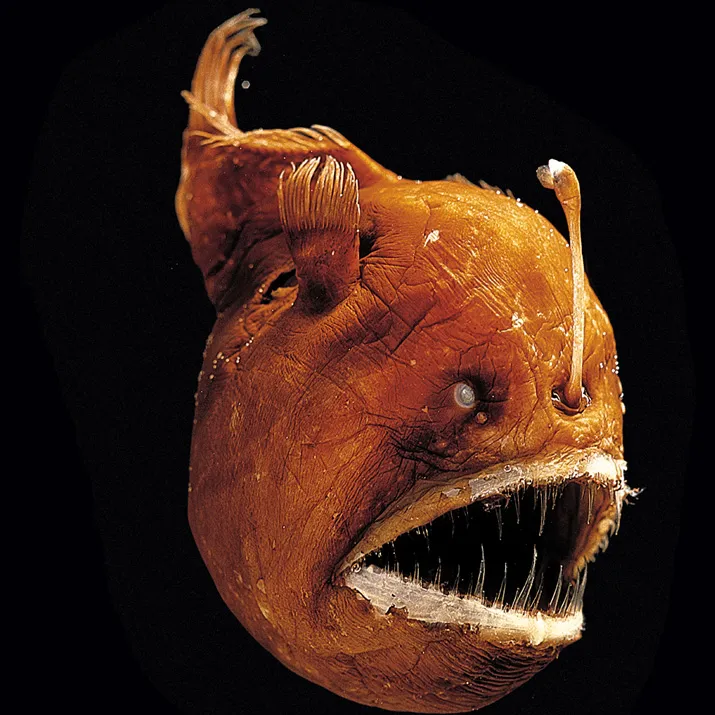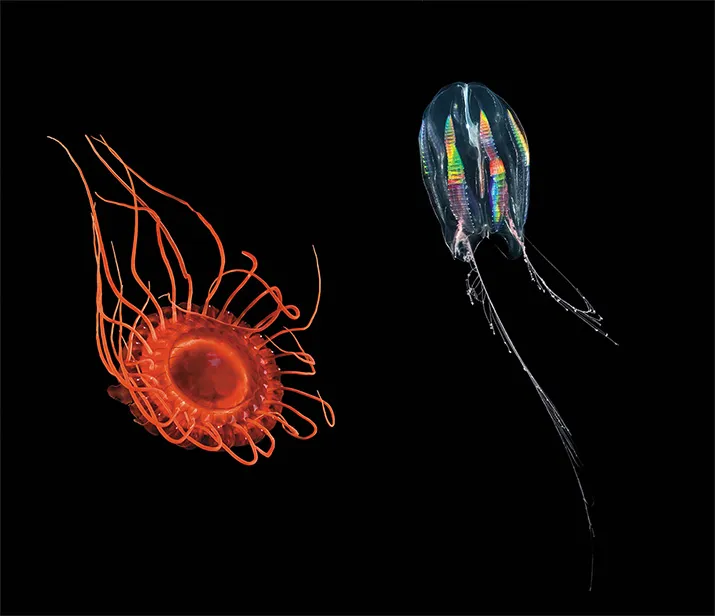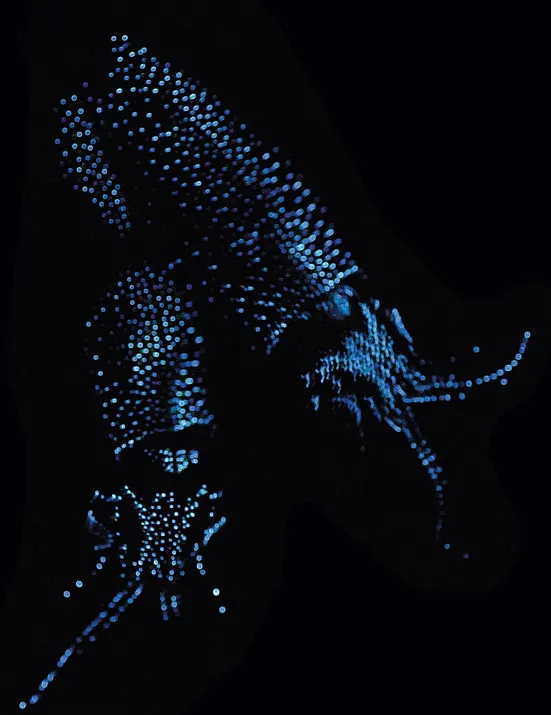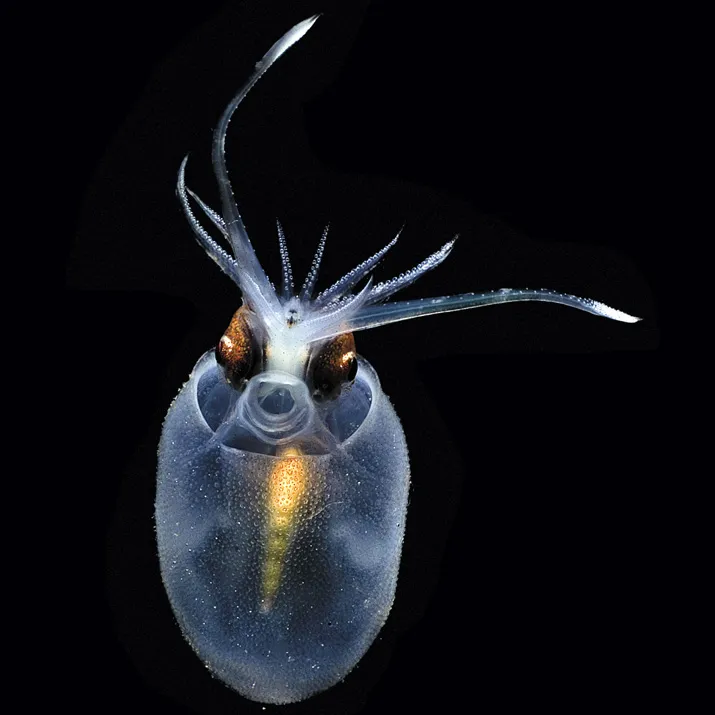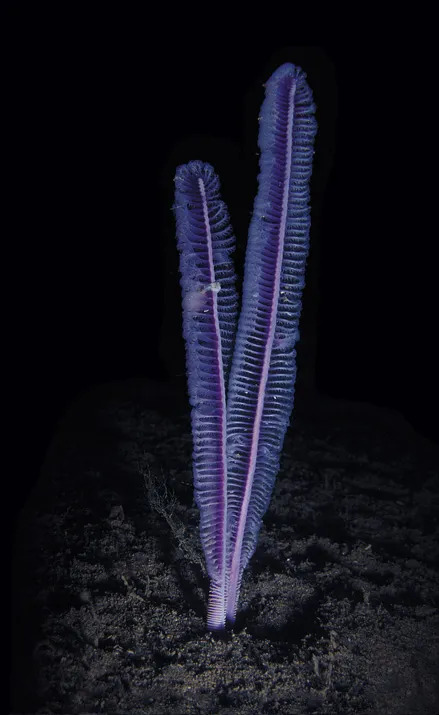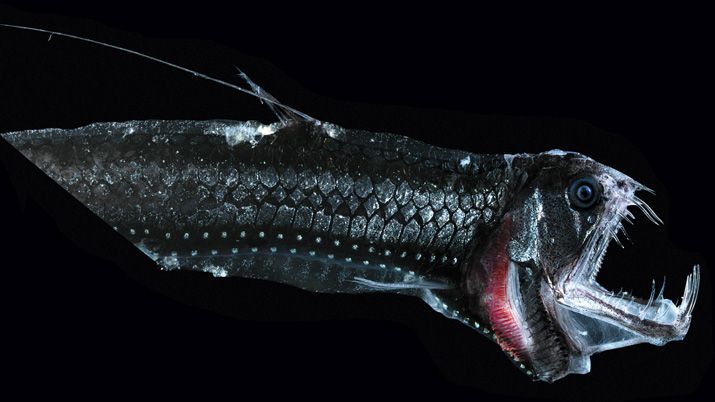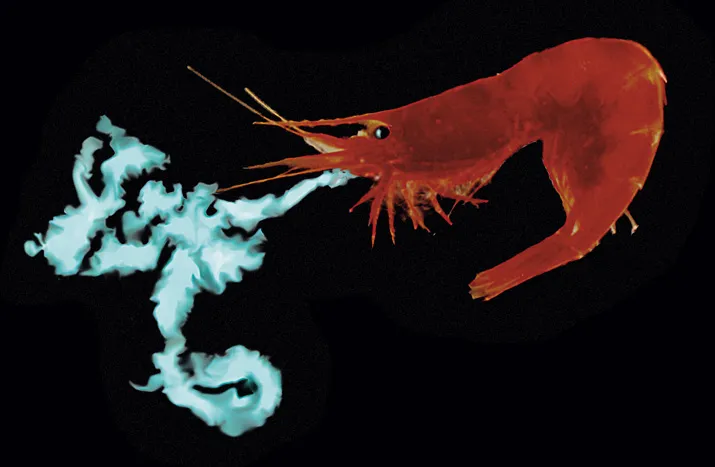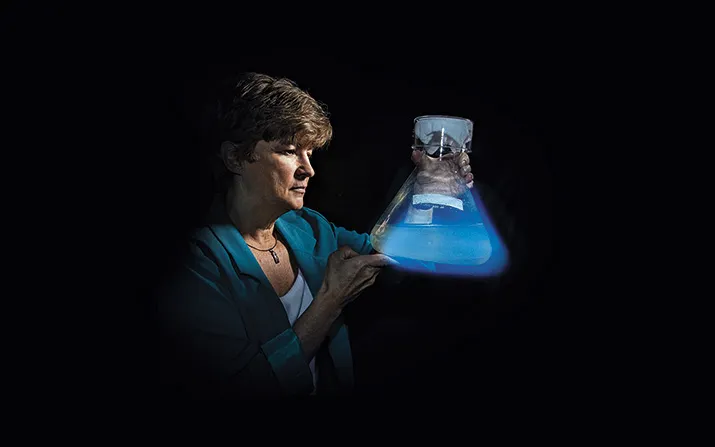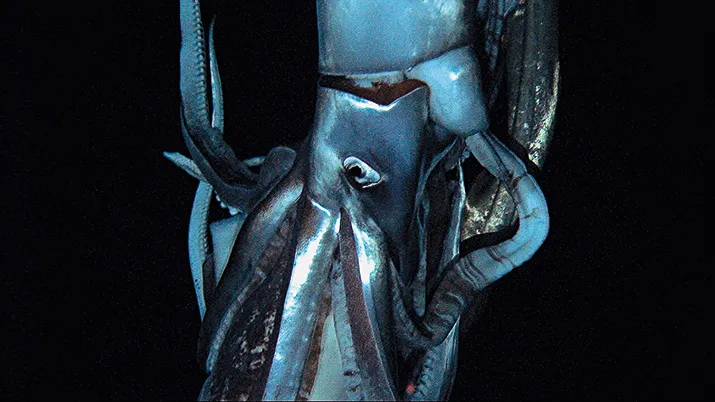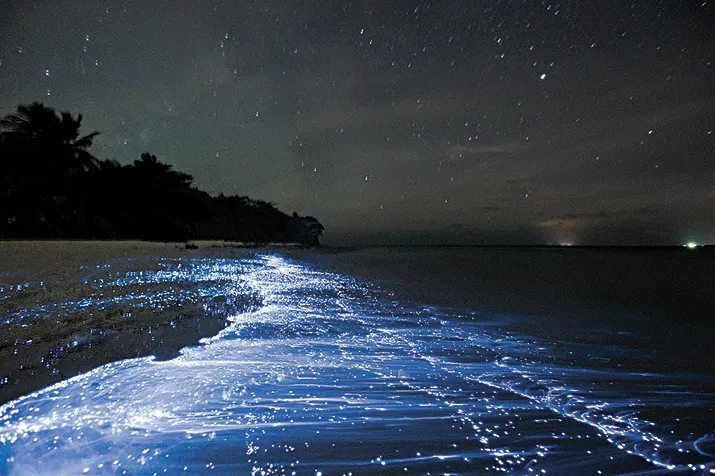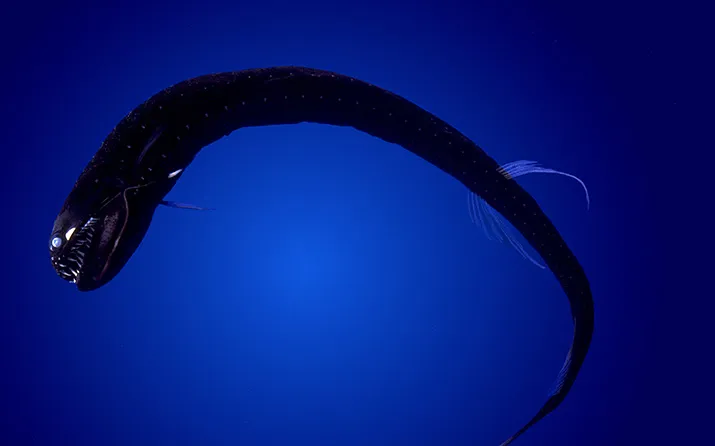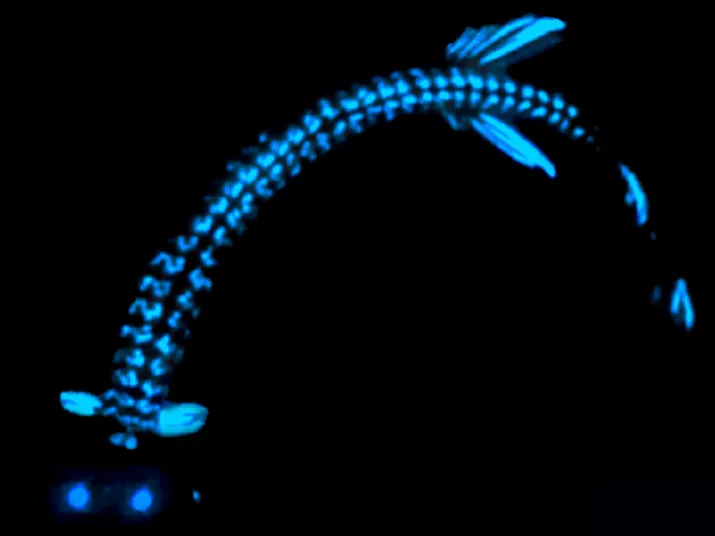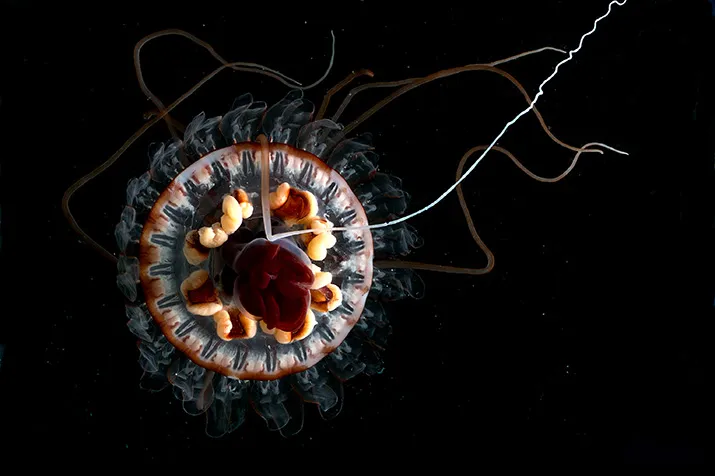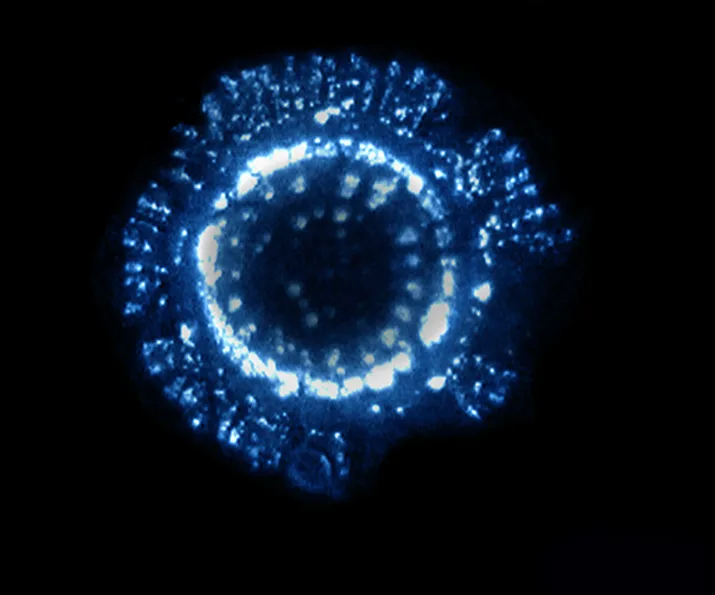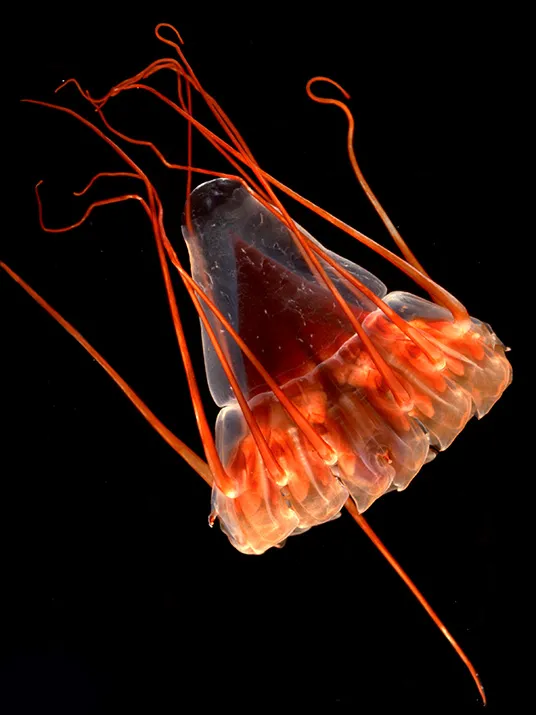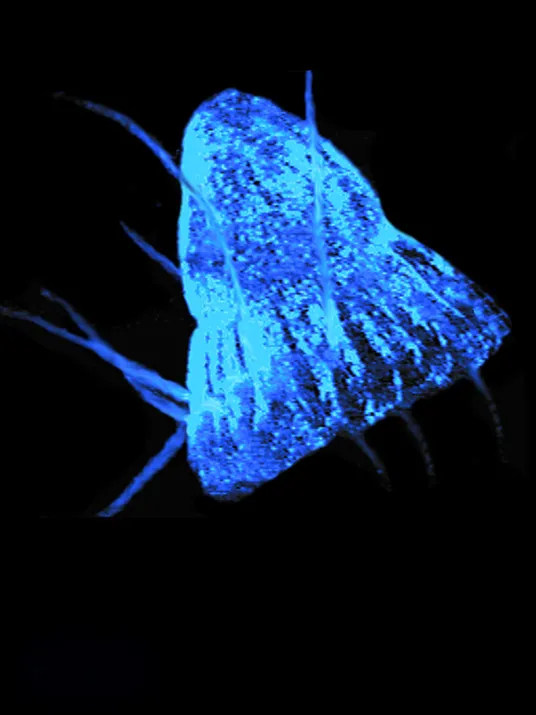Bioluminescence: Light Is Much Better, Down Where It’s Wetter
From tracking a giant squid to decoding jellyfish alarms in the Gulf, a depth-defying scientist plunges under the sea
/https://tf-cmsv2-smithsonianmag-media.s3.amazonaws.com/filer/Light-Fantastic-jellyfish-and-Atolla-manubrium-631.jpg)
“Surface, surface, this is Triton.”
The acrylic sphere floats like a soap bubble in the rough waves, and I drop through the dripping hatch into my seat beside the famed ocean explorer Edith Widder.
We are test-driving a new three-person submarine in choppy waters off Grand Bahama Island. Despite the rocking gusts of wind outside, Widder is serene.
“Surface, surface, this is Triton,” our pilot says. “My hatch is secure. My life-support systems are running.”
“You are cleared to dive,” a static-drowned voice replies.
“OK, folks, here we go.”
We sink.
Widder studies underwater light. From bacteria to sea cucumbers to shrimp and fish, and even a few species of sharks, more than 50 percent of deep-ocean animals use light to holler and flirt and fight. They carry glowing torches atop their heads. They vomit brightness. They smear light on their enemies. Bioluminescence, Widder believes, is the most common, and most eloquent, language on earth, and it’s informing fields from biomedicine to modern warfare to deep-sea exploration. Most recently, on a historic voyage off the coast of Japan, she used her bioluminescent bag of tricks to summon the most legendary sea creature of all: the giant squid.
Today we are hoping to see ostracods, seed-size bioluminescent crustaceans that emerge from shallow sea grass beds and coral reefs some 15 minutes after sunset to put on one of the most sophisticated light shows in nature. The males leave blobs of mucus and radiant chemicals behind them, which hang suspended like glowing ellipses. “The spacing of the dots is species-specific,” Widder explains. “A female knows that if she goes to the end of the right string, she’ll find a male of her species that she can mate with.” This luminous seduction is called the “string of pearls” phenomenon.
Sixty feet below the surface, the pilot steers toward the gnarled limestone labyrinth of a coral reef. A three-foot barracuda gives us the hairy eyeball. A lionfish bristles in our lights. (Because it’s an invasive species, Widder glares back.) The sub leapfrogs between landing pads of soft white sand. We see hog snapper and upside-down jellyfish and a striped sea cucumber. Magnificent sponges resemble egg cups, golf balls and chess pieces. Most flabbergasting are the colors: There are sorbet corals, emerald plates of algae, touches of lavender, banana and rose. Fish dash past in peach and platinum.
But already it’s late afternoon, and these dazzling shades won’t last long. As darkness starts to fall over the Bahamas, the reef’s rainbow fades. The water looks to be filling with gray smoke. “We’ve lost the reds and the oranges,” Widder says as the sub noses through the sudden fog. “You can still see yellow, then that disappears, then you lose green. Soon all you’re left with is blue.” (Almost all bioluminescent creatures manufacture blue light: Its short wavelengths penetrate farthest in seawater.) Some of the animals grow more active as darkness falls. Deep in the chambers of the now-ashen reef, hungry fish stir.
Then our search is cut short by a staticky voice over the radio, summoning us back to the surface because of the bad weather, and we have no choice.
Even as we climb toward the sunset, Widder keeps craning her neck, looking above and behind. “Many discoveries happen just by catching something out of the corner of your eye,” she says. She tells us about William Beebe, the early 20th-century naturalist and explorer and a personal hero of hers, who descended in a steel bathysphere and was the first to watch deep-sea animals in the wild, including what must have been bioluminescent creatures that “exploded” in “an outpouring of fluid flame.” Because he claimed to see so many animals in a short time, scientists later questioned his findings. “I believe he saw what he said he saw,” Widder says. And she has seen much more.
***
The party where I first meet Widder is at a house in Vero Beach, Florida. The exterior is roped in blue lights and the inside is an inferno of tea lights, blue laser lights and flaming rum drinks. Behind the bar a biologist mixes Manhattans by black light. (There are widespread complaints that he is too exact with the whiskey measurement.) A remote-controlled flying Mylar balloon shark, meant to be a bioluminescent species called a cookie-cutter, is making the rounds, its belly coated in glow-in-the-dark paint.
Barely five feet tall but owning the crowd, Widder is a true luminary tonight. She wears a blue glitter-encrusted vest and a headdress of glow sticks. Bright fishing lures adorn her cropped hair. In this ridiculous get-up, she somehow appears perfectly coiffed. She has, 30 years into her deep-sea career, explored waters off the coasts of Africa, Hawaii and England, from the West Alboran Sea to the Sea of Cortez to the South Atlantic Bight. She has consulted Fidel Castro about the best way to prepare lobster (not with wine, in his opinion). She has set sail with Leonardo DiCaprio and Daryl Hannah for a save-the-ocean celebrity event. But for much of her career, she was the unusual one aboard: Many of the research vessels that she frequented in the early days had only ever carried men. Old salts were amused to see that she could tie a bowline knot. And some scientists didn’t realize for years that E. A. Widder, who published with devastating frequency and to great acclaim, was a young woman.
The party is a fund-raiser for her nonprofit, the Ocean Research and Conservation Association (ORCA), based in nearby Fort Pierce. ORCA’s mission is to monitor coastal pollution, particularly in the Indian River Lagoon. Widder fights back tears while she tells the crowd about dolphins dying from pollution in waters just outside the door. Mullet are showing up with lesions, manatees grow tumors. Widder worries about the implications for human health, too. “
When I started ORCA, it was about protecting the ocean I loved,” she says. “But it’s also about protecting ourselves.”
The next morning, Widder and I meet at ORCA headquarters, a former Coast Guard building with a shell-pink roof. On Widder’s crowded bookshelf, two photographs face each other. One shows her mother, a child of Canadian wheat farmers, driving a team of four horses across the Saskatchewan prairie. Her mother was a gifted mathematician, but her career always came second to that of her husband, who headed Harvard University’s math department. She often reminded young Edith of the biblical story of Martha, who was stuck doing dishes when Jesus came to visit. “She told me that you need to be there when the great thinker is in town, not in the kitchen,” Widder remembers. When she was 11, her father took a yearlong sabbatical and the family traveled the world. In Paris, Widder vowed to become an artist; in Egypt, an archaeologist. On the Fijian reefs, where she ogled giant clams and cornered a lionfish (“I didn’t realize it was poisonous”), the ocean captured her heart. (On the same trip, in poverty-stricken Bangladesh, she decided never to have children; she and her husband, David, have kept that promise.)
Next to the photograph of her mother and the horse-drawn plow is one of Widder herself. She’s sealed in a bulky one-person submersible diving suit, more like an astronaut’s spacesuit than any normal diving gear. She is about to embark on one of her first deep-sea dives, and she’s beaming.
That dive marked the rare case where chance, rather than force of will, catalyzed one of Widder’s adventures. She studied biology at Tufts and received a PhD in neurobiology from the University of California at Santa Barbara. As a graduate student, she worked on the membrane biophysics of dinoflagellates, which piqued her interest in bioluminescence, and when her adviser received a grant for a spectrophotometer, a temperamental machine used to measure light, she “just started messing with it to figure it out” and “became the lab expert.” Another scientist requisitioned the new gadget for a 1982 research cruise off the coast of California; Widder went as part of the package.
She had unwittingly stowed away on a landmark mission. Until that time, marine biologists (William Beebe and a few others excepted) had relied on net samples to glimpse deep-sea life, a rather misleading method: Light-bearers, especially, are so delicate they may disintegrate in standard nets, often exhausting their bioluminescence before they reach the surface. But this trip would deploy the WASP, a motorized “atmospheric dive suit” that offshore oil companies had developed to repair underwater rigs. Biologists wanted to use it to observe sea animals instead.
Bruce Robison, the trip’s chief scientist, now at the Monterey Bay Aquarium Research Institute, had handpicked a crack team of scientists, mostly young, gung-ho and male, as potential WASP pilots. One by one they descended more than 1,000 feet in the suit, tethered to the ship by a long cable, while Widder remained at the surface, listening to their jubilant whoops over the radio. “I was just a postdoc, pretty low on the totem pole,” she says. Toward the end of the voyage, Robison asked Widder, by then nearly frantic with enthusiasm, if she wanted to train as a pilot for the next trip.
Her first dive, in the Santa Barbara Channel in 1984, was at sunset. As she sank, the view changed from cornflower blue to cobalt to black. Even with crushing tons of water overhead, she did not experience the clammy panic that makes some pilots’ first dive their last. Passing ethereal jellyfish and shrimp with ultralong antennae that they appeared to ride like skis, she drifted down 880 feet, where sunshine was just a smoggy haze overhead. Then, “I turned out the lights.”
She was hoping for a flash here, a flash there. But what she saw in the darkness rivaled Van Gogh’s Starry Night—plumes and blossoms and flourishes of brilliance. “There were explosions of light all around, and sparks and swirls and great chains of what looked like Japanese lanterns,” she remembers. Light popped, smoked and splintered: “I was enveloped. Everything was glowing. I couldn’t distinguish one light from another. It was just a variety of things making light, different shapes, different kinetics, mostly blue, and just so much of it. That’s what astonished me.”
Why was there so much light? Who was making it? What were they saying? Why wasn’t anybody studying this stuff? “It seemed like an insane use of energy, and evolution is not insane,” she says. “It’s parsimonious.” All too soon the surface crew began winching her in.
On a subsequent expedition to Monterey Canyon she would pilot a dozen five-hour dives, and with each descent she grew more spellbound. Sometimes, the mystery animals outside were so bright that Widder swore the diving suit was releasing arcs of electricity into the surrounding water. Once, “the whole suit lit up.” What she now believes was a 20-foot siphonophore—a kind of jellyfish colony—was passing overheard, light cascading from one end to the other. “I could read every single dial and gauge inside the suit by its light,” Widder remembers. “It was breathtaking.” It went on glowing for 45 seconds.
She’d lashed a blue light to the front of the WASP, hoping to stimulate an animal response. Underwater, the rod blinked frenetically, but the animals all ignored her. “I’m sitting in the dark with this bright blue glowing thing,” Widder says. “I just couldn’t believe nothing was paying attention to it.”
Decoding the bioluminescent lexicon would become her life’s work. Gradually, it dawned on her that before she learned to speak with light, she needed to listen.
***
Widder leads me into a light-tight closet at the back of her lab, then rummages in the fridge for a flask of seawater. It looks clear and still and not too promising. Then she turns off the light and gives the water a little swirl. A trillion sapphires ignite.
This glittering concoction, the color of mouthwash, is full of dinoflagellates, the same planktonic animals that enchant Puerto Rico’s bioluminescent bays and bathe speeding dolphins in otherworldly blue light. The chemistry behind the glow, shared by many bioluminescent creatures, involves an enzyme called luciferase, which adds oxygen to a compound called luciferin, shedding a photon of visible light—a bit like what happens when you snap a glow stick. Stimulated by Widder’s swirl, the dinoflagelletes sparkle to discourage whatever has nudged them—be it a predatory copepod or a kayak paddle—in the hopes that it will forfeit its meal.
Larger animals exhibit the same startle response: Lit up along their light grooves, gulper eels look like cartoon electrocutions. Widder eventually realized that the Vegas-like displays she saw from the WASP were mostly examples of startle responses stimulated by contact with her diving suit.
Only a tiny percentage of terrestrial life is bioluminescent—fireflies, most famously, but also some millipedes, click beetles, fungus gnats, jack-o’-lantern mushrooms and a few others. The one known luminous freshwater dweller is a lonely New Zealand limpet. Most lake and river residents don’t need to manufacture light; they exist in sunlit worlds with plenty of places to meet mates, encounter prey and hide from predators. Sea animals, on the other hand, must make their way in the obsidian void of the ocean, where sunlight decreases tenfold every 225 feet, and disappears by 3,000: It’s pitch-black even at high noon, which is why so many sea creatures express themselves with light instead of color. The trait has evolved independently at least 40 times, and perhaps more than 50, in the sea, spanning the food chain from flaring zooplankton to colossal squid with large light organs on the backside of their eyeballs. Mollusks alone have seven distinct ways of making light, and new incandescent beings are being spotted all the time.
Scientists today believe that bioluminescence is always a means of influencing other animals—a signal fire in the deep. The message must be important enough to outweigh the risks of revealing one’s location in the blackness. “It’s the basic stuff of survival,” Widder says. “There’s incredible selective pressure on the visual environment, where you have to worry about what’s above you if you’re a predator and what’s below you if you’re prey. Often, you’re both.”
In addition to activating their startle responses, hunted animals also use light as camouflage. Many midwater predators have permanently upward-pointed eyes, scanning overhead for prey silhouetted against the downwelling sunlight. Viewed thus, even the frailest shrimp becomes an eclipse. So prey animals dapple their bellies with light organs called photophores. Activating these bright mantles, they can blend in with the ambient light, becoming effectively invisible. Fish can snuff out their stomachs at will, or dim them if a cloud passes overhead. The Abralia squid can match the color of moonlight.
Luring food is the second bioluminescent motive. The aptly named flashlight fish sweeps the darkness with its intense cheek lights, looking for tasty neighbors. In front of its cruel jaws, the viperfish dangles a glowing lure on the end of a mutated fin ray that resembles, to hungry passersby, a resplendent piece of fish poop—a favored deep-sea snack. (Rather than kindling their own light, some of these predators enjoy symbiotic relationships with bioluminescent bacteria, which they culture inside light-bulb-like cavities that they can snuff with sliding flaps of skin or by rolling the light organs up into their heads, “exactly like the headlights of a Lamborghini,” Widder says.)
Finally, light is used to recruit mates. “We think they flash specific patterns, or have species-specific-shaped light organs,” Widder says. Female octopods sometimes set their mouths ablaze with glowing lipstick; Bermuda fireworms enliven the shallows with ravelike green orgies. Most romantic of all is the love light of the anglerfish, one of Widder’s favorite animals. The female, a fearsome gal with a toothy underbite, brandishes a lantern of glowing bacteria above her head. The male of her species, tiny and lanternless but with sharp eyes, swims toward her and smooches her side; his lips become fused to her body until she absorbs everything but his testes. (You might say that she will always carry a torch for him.)
Some sea creatures’ use of light mystifies Widder. Why does the shining tube-shoulder fish shrug out light? Why does the smalltooth dragonfish have two headlights instead of one, in slightly different shades of red? How does the colossal squid use its light organ?
These questions aren’t just theoretical. Much of Widder’s early funding came from the U.S. Navy. Tiny creatures that could highlight the shape of a hidden submarine are a national security concern, so Widder invented a tool to measure light levels. Called a HIDEX, it sucks large amounts of seawater, and any bioluminescent animals within, into a light-tight chamber and reads their glow. “It tells you about the distribution of organisms in the water column,” she says.
Once she found a way to measure undersea light, she started trying to distinguish more precisely among the myriad lightmakers. On her increasingly frequent deep-water excursions, Widder had begun to watch for themes in the strobelike spectacles. Different species, it seemed, had distinct light signatures. Some creatures flashed; others pulsated. Siphonophores looked like long whips of light; comb jellies resembled exploding suns.
“To most people it looks like random flashing and chaos,” says Robison, who became one of Widder’s early mentors. “But Edie saw patterns. Edie saw that there is a sense to the kind of signals that the animals are using, and the communications that take place down there. That was a breakthrough.”
What if she could identify animals just by the shape and duration of their glow circles? She could then conduct a bioluminescent census. Widder developed a database of common light codes that she’d learned to recognize. Then she mounted a three-foot-wide mesh screen on the front of a slow-moving submarine. When animals struck the mesh, they blasted their bioluminescence. A video camera recorded the flares, and a computer image-analysis program teased out the animals’ identity and location. Widder was gathering the sort of basic information that land-based biologists take for granted, such as whether, even in the ocean, certain species are territorial. The camera was also a window into the nightly swarming of deep-sea creatures toward the nutrient-rich surface—the “vertical migration” that is considered the largest animal migration pattern on the planet. “The whole water column reorganizes itself at dusk and dawn, and that’s when a lot of predation happens,” she says. “Do certain animals hang back and vertically migrate at different times of day? How do you sort that out?”
As useful as these inventions proved, some of Widder’s most stunning discoveries came to light just because she was hanging out in the right place at the right time, as her mother told her to do. Often that was about 2,500 feet underwater. On a submersible in the Gulf of Maine, Widder trapped a foot-long red octopus and brought it to the surface. It was a well-known species, but Widder and a graduate student were the first to examine it in the dark. (“People just don’t look,” she sighs.) Flipping off the lights in their lab, they were astonished to see that where suckers are found on other octopuses, rows of gleaming light organs instead studded the arms. Perhaps run-of-the-mill suckers were not useful to an open-ocean resident with few surfaces to cling to, and carnivalesque foot lights, likely used as a “come hither” for the animal’s next meal, were a better bet. “It was evolution caught in the act,” Widder says.
***
Even though the twinkling lingo of light is more complicated and far subtler than she initially imagined, Widder never stopped wanting to speak it. In the mid-1990s, she envisioned a camera system that would operate on far-red light, which humans can see but fish cannot. Anchored to the seafloor and inconspicuous, the camera would allow her to record bioluminescence as it naturally occurs. Widder—ever the gearhead—sketched out the camera design herself. She named it the Eye-in-the-Sea.
She lured her luminous subjects to the camera with a circle of 16 blue LED lights programmed to flash in a suite of patterns. This so-called e-Jelly is modeled on the panic response of the atolla jellyfish, whose “burglar alarm” display can be seen from 300 feet away underwater. The alarm is a kind of kaleidoscopic scream that the assaulted jellyfish uses to hail an even bigger animal to come and eat its predator.
The Eye-in-the-Sea and e-Jelly were deployed in the northern Gulf of Mexico in 2004. Widder placed them on the edge of an eerie undersea oasis called a brine pool, where methane gas boils up and fish sometimes perish from the excess salt. The camera secure on the bottom, the e-Jelly launched into its choreographed histrionics. Just 86 seconds later, a squid lurched into view. The six-foot-long visitor was completely new to science. When deployed in the Monterey Canyon, Widder’s Eye-in-the-Sea captured stunning footage of giant six-gill sharks rooting in the sand, possibly for pill bugs, a never-before-seen foraging behavior that might explain how they survive in a desolate environment. And in the Bahamas at 2,000 feet, something in the blackness flashed back at the e-Jelly, emitting trails of bright dots. Each time the jelly beckoned, the mystery creature sparkled a response. “I have no idea what we were saying,” she admits, “but I think it was something sexy.” At long last, Widder was engaged in light conversation, most likely with a deep-sea shrimp.
A sensational highlight came last summer in the Ogasawara Islands, about 600 miles south of Japan, when Widder, the e-Jelly and a floating version of the Eye-in-the-Sea called the Medusa joined an effort to film the elusive giant squid in its natural habitat for the first time. Other missions had failed, although one captured footage of a dying giant at the surface. Widder was nervous to use her lure and camera in the midwater, where the devices dangled from a 700-meter cable instead of resting securely on the bottom. But during the second, 30-hour-long deployment, the Medusa glimpsed the squid. “I must have said ‘Oh my God’ 20 times, and I’m an agnostic,” she says of first seeing the footage. The animals can supposedly grow to be over 60 feet long. “It was too big to see the whole thing. The arms came in and touched the e-Jelly. It slid its suckers over the bait.”
She caught more than 40 seconds of footage and a total of five encounters. At one point, the squid “wrapped itself around the Medusa, with its mouth right up near the lens,” Widder says. The huge squid didn’t want the puny little e-Jelly; rather, it was hoping to eat the creature that was presumably bullying it. Another scientist on the same voyage subsequently filmed a giant squid from the submarine, and that footage, along with Widder’s, made headlines. It was e-Jelly’s pulsating light that roused the giant in the first place, making history. “Bioluminescence,” Widder says, “was the key.”
***
The winking dinoflagellate blooms in the Indian River Lagoon on Florida’s east coast can be so bright that schools of fish look etched in turquoise flame. It’s possible to identify the species swimming in the lit-up water: Local residents call this guessing game “reading the fire.”
But there isn’t as much fire to read anymore. Long considered North America’s most diverse estuary, the lagoon may now be dying. Pollution has thinned the dinoflagellate blooms, and the light from thousands of new houses drowns out the remaining brightness. Animals once wreathed in blue fire are ailing, too. Many dolphins are afflicted by a flesh-eating fungus that corrodes their skin; others are infected by viruses and have severely suppressed immune systems. Luxurious sea grass beds grow bald, leaving conch and periwinkle snails without shelter. Mammoth algae blooms stink like rotting eggs. The shellfish industry is in shambles.
These ills are not unique to Florida waters. Two abysmal assessments of the ocean’s overall health—the Pew Ocean Report in 2003 and the U.S. Commission on Ocean Policy’s in 2004—spurred Widder to leave her longtime position as a senior scientist at Florida’s Harbor Branch Oceanographic Institute and start ORCA. “Ever since I did my first dive, I’ve been asking why is there all that light in the ocean and what is it used for,” she says. “More recently, I’ve come around to figuring out what we can use it for.”
Scientists are hotly pursuing applications for bioluminescent technology, particularly in medical research, where they hope it will change how we treat maladies from cataracts to cancer. In 2008, the Nobel Prize in Chemistry honored cell biology advances based on the crystal jellyfish’s green fluorescent protein, a bioluminescent substance that is used to track gene expression in laboratory samples. Widder is focused on the uses of luminous bacteria, which are extremely sensitive to a wide array of environmental pollutants.
One day we tour the lagoon in a little flat-bottomed fishing boat. It’s a dense green world, interrupted here and there by the pastel crags of Floridian architecture. A wisp of an egret wanders the shore and pelicans on top of pilings appear sunk in contemplation. Fingers of mangrove roots protrude from the inky banks. More than 150 miles long, the lagoon is a home to logjams of manatees, a rest stop for migratory birds and a nursery for bull and bonnet sharks. But water that 30 years ago was gin clear now looks more like bourbon.
The sources of pollution here are discouragingly diverse: There’s airborne mercury from China, fertilizer and pesticide runoff from inland citrus and cattle farms, even the grass clippings from local lawns. “There are literally thousands of chemicals being released into our environment and nobody is keeping track of them,” Widder says. So much of the surrounding wetlands have been paved and drained that the lagoon is fast becoming a sink for the land’s poisons. It’s hard to imagine a bright future for the place.
To protect the lagoon, Widder has designed ocean monitors that track currents, rainfall and other variables, mapping where water comes from and where it goes in real time. She wants this network to one day span the world—“the wired ocean.”
Now she’s studying the lagoon’s most polluted parts, which she identifies with the help of bioluminescent life-forms. Wearing yellow kitchen gloves, we shovel gray-green muck from the foot of ORCA’s dock, an area that Widder has never tested before. A lab assistant homogenizes the sample in a paint mixer, then retrieves a vial of freeze-dried bioluminescent bacteria. It’s Vibrio fischeri, the same strain that the fireshooter squid uses for its deep-sea dragon breath. She drops it, along with little drips of the lagoon mud, into a Microtox machine, which monitors the light. We can’t see it with our naked eyes, but the healthy bacteria are glowing at first.
“The light output of bacteria is directly linked to the respiratory chain,” Widder explains. “Anything that interferes with respiration in the bacteria quenches the light.” Interfering substances include pesticides, herbicides, petroleum byproducts and heavy metals, and the more they quench the light, the more toxic they are.
Widder and the lab assistant don’t think the mud from outside the door will prove too toxic, but they are wrong: Within half an hour, readings show that the bacteria’s living lights are dim, and in the most concentrated samples, they have burned out.
